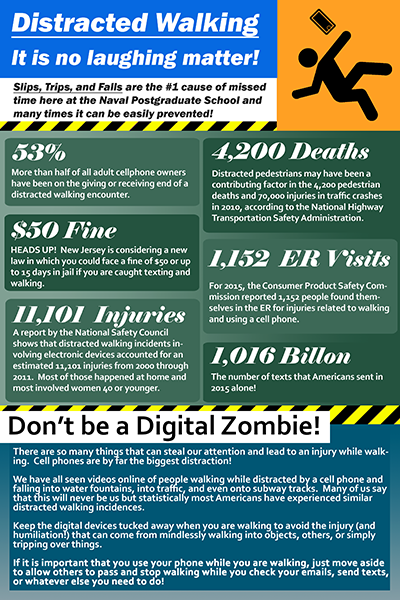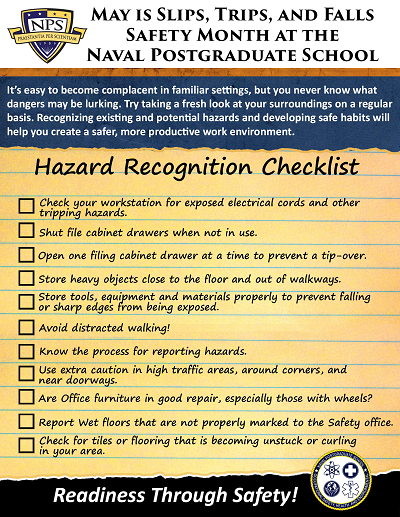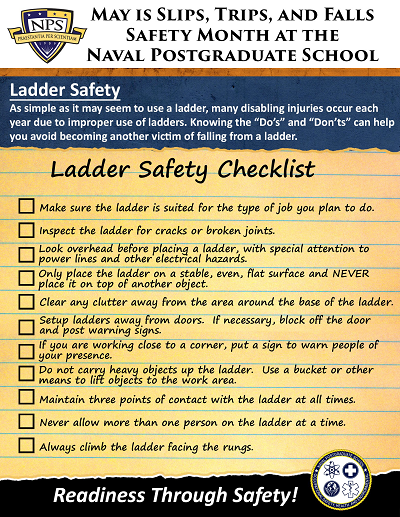Slips Trips and Falls - Safety
Slips, Trips, and Falls
Our #1 Cause of Mishaps!
Slips, trips, and falls is one of the highest causes of mishaps at NPS and oftentimes they are easily prevented. There are so many things that can steal our attention and lead to an injury while walking. Cell phones are by far the biggest distraction!
Slips, trips, and falls are the number one cause of lost workdays in the Navy, according to a three-year study by the Naval Safety Center (NAVSAFECEN). Off-duty falls are the second leading cause of death next to highway crashes, according to the National Safety Council. On-duty ladder mishaps result in more lost workdays than any other mishap reported in the Web Enabled Safety System. Multiple factors contribute to falls on ladders, including running, carrying heavy objects that obstruct the view and movement, sliding down ladders and not utilizing handrails.
NAVSAFECEN reminds everyone that slips, trips, and falls are preventable. Slow down, use your trailing hand to hold the handrail while transiting a ladder and watch your step at all times to help ensure your safety.
How Serious is this Hazard?
- Slips-and-falls account for more workplace injuries and deaths than any other category.
- Falls from ladders and scaffolds kill 350 people and injure 180,000 more every year.
- Falls on stairways disable more than 33,000 people every year.
The Most Common Causes of Slips and Trips are:
- Inattentiveness! – always pay attention to where you’re walking
- Wet or worn surfaces – inspect surfaces carefully and clean up non-chemical spills
- Materials, tools, boxes and trash left lying around – keep our walk and work areas clean
- Raises or drops in the floor’s elevation – be aware of those areas of floor height change
- Old, worn or inappropriate footwear – wear slip-resistant shoes that are right for the job
- Poorly lit areas – never enter a poorly lit area and notify supervisors of such areas.
Use Ladders Safely:
- Inspect your ladder for cracks, loose or damaged rungs, broken locks or pulleys, and frayed or worn ropes.
- Place your ladder on a stable, level surface and protect it from accidental tipping by cars and people. Tie the top and bottom to a secure location or have someone steady it for you.
- When climbing, always face the ladder and keep your hands free. Never overextend yourself and keep three points of contact with the ladder at all times.
- Be sure to leave proper overhand on extension ladders, and set them one foot away from the way for every four feet of working ladder height.
- Always remember to lock the spreaders on step ladders before climbing.
Preventing Other Falls:
- Always inspect the steps before using stairs. Use the handrail, and avoid running or carrying loads that impair your vision.
- Inspect framing and planking of scaffolds before use, ensure proper guardrails are in place and only climb those parts of a scaffold intended to be climbed.
- Be particularly careful on loading docks and vehicles. Docks are exposed to many dangerous conditions. Vehicles can move suddenly, causing a serious fall.
- Cover floor openings as soon as they’re created to keep everyone safe.
- Install guardrails and safety nets when needed. Always put on your safety harness when needed and use it throughout the job.
- If you spot a hazard: Fix it / Flag it, Forewarn your coworkers and Find a supervisor.
- We can all take simple steps to prevent slips, trips and falls.




